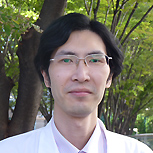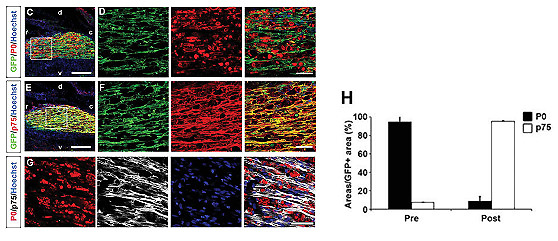- 2012年度
- 大脳皮質の進化の謎に迫る
(2013/03/29) - 活性型ビタミンDで小胞体ストレスを緩和しよう!
(2013/03/29) - Sweat Glands Grown from Newly Identified Stem Cells
(2013/03/29) - ~筋肉の恒常性と健康は相反するものなのか?~ 筋肉においてオートファジーが存在するが故にインスリン抵抗性が存在する
(2013/03/29) - たった1つの因子の抑制で様々な細胞が神経に!?
(2013/03/28) - 乳酸菌を取り込むと、細胞も若返る?! ~"人間、またしても発酵食品のお世話になる"の巻~
(2013/03/27) - 脳腫瘍における新しい遺伝子変異~エピジェネティク
(2013/03/27) - CCR2-dependentrecruitment of macrophages by tumor-educated mesenchymal stromal cells promotes tumor development and is mimicked by TNFα
(2013/03/25) - 補体C1qはWntシグナルの活性化を介して細胞を老化させる
(2013/03/19) - Speramtogonial Stem Cell Transplantation into Rhesus Testes Regenerates Spermatogenesis Producing Functional Sperm.
(2013/03/12) - 糖尿病薬剤による抗腫瘍効果
(2013/03/12) - 難病ALSの新たな原因遺伝子の発見
(2013/03/12) - 脊髄損傷にヒートショックプロテインが有効?
(2013/03/11) - 片頭痛患者では血管内皮前駆細胞が少ない?
(2013/03/11) - 筋幹細胞の静止状態はmiRNA-489により維持される
(2013/03/11) - ストレスに弱いってどういうこと?(心の病気にかかるメカニズムの一つ、「ストレス脆弱モデル」をネズミで再現)
(2013/03/09) - 核酸医薬は実現するか~筋強直性ジストロフィー治療の可能性~
(2013/03/09) - なくならないのは技がある!
(2013/03/08) - Down症候群のiPS細胞の染色体数を修正する
(2013/03/08) - 高品質なiPS細胞作製のキーファクターZscan4の同定
(2013/03/08) - Turning off the Neuron Death Pathway
(2013/03/07) - 新しい安全な分子標識-マルチ同位体画像質量分析法-が明らかにした幹細胞の不等分裂様式
(2013/03/07) - 重度脊髄損傷後に移植した神経幹細胞が非常に長く軸索を伸長し、シナプス結合した!
(2013/03/07) - 神経系前駆細胞を元気にして水頭症を治す!?
(2013/03/05) - FUS/TLSとTDP-43 二つのALS原因遺伝子の交差点
(2013/03/01) - 貪食細胞マクロファージが造血幹細胞を優しく包み込んで自己複製能の維持に貢献していた!?
(2013/02/27) - TALENs -新遺伝子改変技術が生命科学を変える!?-
(2013/02/27) - RESTタンパク質による遺伝子発現調節 ~遺伝子発現とシナプス機能~
(2013/02/25) - 腸に住んでいるある平凡な細菌によって大腸がんは引き起こされる!
(2013/02/25) - 癌抑制遺伝子p53の変異はメバロン酸経路を活性化することで、正常な乳腺の構造を失わせる
(2013/02/25) - 樹状細胞は制御性T細胞の恒常性をコントロールすることで多発性硬化症を寛解させる
(2013/02/25) - Schwann Cell Plasticity After Spinal Cord Injury Shown by Neural Crest Lineage Tracing
(2013/02/15) - エクソソームは、癌細胞の「飛び道具」!
(2013/02/08) - 老化したニッチでは筋肉幹細胞は静止状態を保てない
(2013/01/31) - 幹細胞を使った創薬開発
(2013/01/31) - 体細胞リプログラミングにおける遺伝子発現調節の解析からわかること-single cellで見てみようの巻-
(2013/01/31) - がん幹細胞発生のかぎを握るのは誰?-ユーイング肉腫がん幹細胞の解析を通じた検証-
(2013/01/31) - 小動物用PET(Positron Emission Tomography)で、ラットの脳梗塞巣を探知することができる [18F]BMS-PET
(2013/01/31) - 脳の神経ネットワークにおけるヤングパワー!
(2013/01/18) - アストロサイトの性格はどうやって決まる?
(2013/01/18) - 幹細胞の自己複製能を制御する因子とは?
(2013/01/18) - アルデヒドが真犯人!?DNA損傷と再生不良性貧血
(2012/12/18) - HIV-2の新しい定量法
(2012/12/18) - Japanese People's Preference for Place of End-of-Life Care and Death: A Population-Based Nationwide Survey
(2012/12/18) - がん細胞の死に際
(2012/12/18) - 癌幹細胞を眠りから目覚めさせる"Coco"
(2012/12/13) - 細胞接着分子のインテグリンが血液の幹細胞の維持を制御する
(2012/12/11) - 移植された神経幹細胞は免疫系にも作用する
(2012/12/11) - 血液がん克服にむけて!~JAK2阻害剤の薬剤耐性メカニズム解明~
(2012/12/04) - 癌進展を陰で操る支配者
(2012/11/30) - 幹細胞の2つの顔を暴け!!! 未分化性維持と特異的分化との狭間で...
(2012/11/30) - 脊髄損傷後の機能回復には自発的なリハビリが効果的
(2012/11/21) - もしあなたの歯が無くなってしまった時に...
(2012/11/15) - iPS細胞から血小板をつくる
(2012/10/30) - メラノーマのエキソソームで予後予測ができる?!
(2012/10/30) - Oligodendroglia Cells Can Do Much More Than an Insulator for Neuron
(2012/09/11) - APJは、心臓肥大のデュアル受容体として作用する
(2012/09/11) - 幹細胞医療;脳梗塞治療への挑戦
(2012/09/11) - 造血幹細胞の老化と若返り
(2012/09/11) - カロリー制限が筋肉を増やす? - トレーニング界の常識に挑戦する新たな"逆説"
(2012/09/11) - 癌幹細胞は治療標的にならない!?
(2012/08/24) - iPS細胞でC型肝炎ウイルス感染のモデルをつくる
(2012/08/09) - ES細胞、iPS細胞から内耳有毛細胞への分化誘導
(2012/08/09) - 造血幹細胞を冬眠させる細胞はなんと神経系の細胞だった!
(2012/07/06) - 個別化治療への障壁 ~多重人格なガンを克服せよ~
(2012/07/06) - 栄養のバランスが新しいニューロンを作り、体重や新陳代謝をコントロールする
(2012/05/11) - 脊髄不全損傷後におこる、残存神経ネットワークの代償機能
(2012/05/11) - "スーパーPTENマウス"
(2012/04/20) - 統合失調症iPS細胞研究が臨床研究になるために
(2012/04/20) - 発癌機序における"はじめの一歩"
(2012/04/06) - iPS細胞は脊髄損傷を治せるのか?
(2012/04/06)
- 大脳皮質の進化の謎に迫る
- 2011年度
- 2010年度
ホーム > 世界の幹細胞(関連)論文紹介 > Schwann Cell Plasticity After Spina...
Schwann Cell Plasticity After Spinal Cord Injury Shown by Neural Crest Lineage Tracing
論文紹介著者

WU HAO(博士課程 1年)
GCOE RA
整形外科 (Department of Orthopedic Surgery)
第一著者名・掲載雑誌・号・掲載年月
NARIHITO NAGOSHI/NARIHITO NAGOSHI,1,2,3 SHINSUKE SHIBATA,1 MAKOTO HAMANOUE,4 YO MABUCHI,1 YUMI MATSUZAKI,1. GLIA 59:771-784 (2011)
論文解説
Introduction
Only a few treatments are currently available for spinal cord injury (SCI), a life-threatening traumatic disorder, and full functional recovery is rare. The nervous tissue damage from SCI occurs in several stages, including a primary phase of physiological damage with hemorrhage or ischemia, and a secondary phase of further destruction by infiltrating inflammatory cells. During the secondary phase, various cell types are recruited to the site of injury and contribute to not only the degenerative response, but also the regenerative one.
Schwann cells, which normally inhabit the peripheral nerves, including the nerve roots, but not the intact spinal cord, appear in the spinal-cord lesion site and remyelinate (myelinate the injured myelin sheath again) the surviving axons.
Summary
After spinal cord injury (SCI), various cell types are recruited to the lesion site, including Schwann cells, which originate in the neural crest and normally myelinate axons in the peripheral nervous system. Authors investigated the differentiation states, migration patterns, and roles of neural crest derivatives following SCI, using two transgenic mouse lines carrying neural crest-specific fluorescence reporters(EGFP: Enhanced Green Fluorescent Protein). In these mice, EGFP is expressed only in the neural crest cell lineage. Most of the EGFP+ cells that infiltrated the lesion site after SCI were Schwann cells.

Seven days after SCI, the P0-positive, mature Schwann cells residing at the nerve roots had dedifferentiated into P0-/p75+ immature Schwann cells, which proliferated and began migrating into the lesion site.

Thereafter, the number of EGFP+/p75+ immature Schwann cells decreased and that of EGFP+/P0+ mature cells increased gradually, indicating that the cells redifferentiated into mature Schwann cells within the lesion site.

Conclusion
- EGFP+ neural crest-derived cells migrate into the lesion epicenter from the peripheral nerves after SCI.
- Mature Schwann cells of nerve roots dedifferentiate and migrate into the lesion site after SCI.
- Immature Schwann cells reacquire their maturity and remyelinate axons at the lesion site.
Schwann cell migration into the CNS lesion site is a natural repair mechanism for SCI. Transplanted Schwann cells provide trophic support for spared axons and participate in their remyelination; furthermore, the recruitment of Schwann cells to the lesion site enhances functional recovery after SCI. Myelination contributes to functional recovery, the targeting of immature Schwann cells to enhance their redifferentiation could be a potential therapeutic strategy for SCI.
用語解説
- ※1 Spinal cord injury (SCI):
Spinal cord injury (SCI) refers to any injury to the spinal cord that is caused by trauma instead of disease. Depending on where the spinal cord and nerve roots are damaged, the symptoms can vary widely, from pain to paralysis to incontinence. Spinal cord injuries are described at various levels of "incomplete", which can vary from having no effect on the patient to a "complete" injury which means a total loss of function. - ※2 P0:
a marker for mature myelinating Schwann cells. - ※3 p75:
a marker of immature and nonmyelinating Schwann cells.
Copyright © Keio University. All rights reserved.
